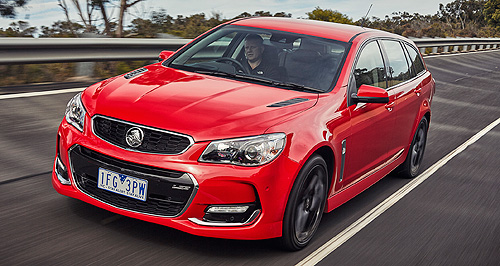New models - Holden - CommodoreVF Series II Commodore pumps up the volumeLet’s get loud: The 304kW/570Nm LS3 Chevy Corvette-sourced engine ensures the VF Series II is the quickest Commodore yet. Holden dives deep into acoustics to keep die-hard Commodore fans happy14 Sep 2015 By IAN PORTER GM HOLDEN has taken the V8 driver’s care-free attitude to fuel consumption to a whole new level with an exhaust system on the Series II V8 Commodores that snaps, crackles and pops when extra fuel is injected on the overrun. The use of fuel to create detonations in the exhaust system is just one of three different ways in which Holden has enhanced the aural sensation of driving “the quickest Commodore ever”. In a message directed straight at its enthusiast customer base, Holden has based its appeal on a message not seen since the days of the Pony Cars and the horsepower war: power and speed. It may be politically incorrect, but it’s simply a reflection of market realities for Holden. “Currently we have increased V8s up to about a third of the volume, and we’d certainly like to stay at that level,” Holden chairman and managing director Mark Bernhard said at the reveal of the VF Series II Commodore at the Port Melbourne headquarters on the weekend. “There are a number of enthusiasts that really want this car, and this LS3 V8 engine is really targeting that market.” The LS3 is a 6.2-litre American-built engine that is found in GM’s Corvette sportscar and produces 304kW of power and 570Nm of torque. The previous V8, the LS2, made 270kW and 530Nm. The LS3 makes the Series II the quickest non-HSV Commodore, with a 0-100km/h time of 4.9 seconds. The V8 engine will be available in nine of the 22 different Commodore models, with the cheapest V8 available being the SS V manual sedan at $47,990 plus on-road costs. It is expected that most of the V8 Commodores sold will be the SS, SS V and the SS V Redline sports models, with the V8 available in the ute only in SS V Redline trim. Holden vehicle chief engineer Andrew Holmes was clear about the sports orientation of the new engine. “My team has done a lot more work under the bonnet than you can see here today, and that’s largely in response to our V8 customers who have said ‘Can we have more of everything, please?’,” he said at the reveal. Apart from power and acceleration, the drivers Holden spoke with wanted some more noise. Market research showed potential buyers wanted more “theatre” when driving the V8. “It wasn’t enough for the car to go well, it also had to sound like it goes well.” After “endless hours” of local testing, Mr Holmes and his engineers came up with a three-pronged solution, a bi-modal exhaust system as has been seen on recent HSVs, an under-bonnet sound enhancer and the fuel-induced exhaust system snaps, crackles and pops. Mr Holmes was quick to point out that the detonations in the exhaust system cost an infinitesimally small amount of fuel. Minute sprays of fuel into the exhaust stream produce these detonations, but Mr Holmes said this does not affect fuel economy in any meaningful way. “It costs so little in fuel that there is no way someone would be able to achieve better fuel economy in the real world. “So, whilst it is all about the theatre, and sounding a bit more like a benchmark – an AMG Mercedes, for instance – it really isn’t costing anything. Nothing you could measure.” Mr Holmes said the fact that the new V8 uses more fuel than the previous engine is connected to the engineering effort needed to reduce the CO2 emissions of the LS3 engine, not the exhaust system theatrics. The bi-modal exhaust system is similar to that used on HSV models, switching between soft and loud mode via a Holden-designed “Baillie Tip”. Mr Holmes said the V8 Commodore passes the 75-decibel drive-past test in both modes. The third element to the aural stimulation program is under the bonnet. Mr Holmes’ engineers have devised a method of piping engine bay noise into the cabin without resorting to fake soundtracks delivered through the in-dash radio system, as is found on some other vehicles. “We have also added a mechanical sound enhancer under the bonnet, too, and that allows us to balance the sounds from the front end and the rear of the car.” This enhancer involves tapping into the induction system just behind the air filter box, where the pressure pulses from the engine can be felt. These pulses are fed into a diaphragm with a taut “drum skin” to amplify the sound. “We tune the drum skin in order to make the noises we want it to make, taking the components of the noise we like, and then we run it through this tube, through a hole in the dash and we pipe engine noise into the cabin. “It’s very simple, very effective, and the amount of noise is totally dependent on how much you press the pedal.” Mr Holmes said the noise is not always there. “If you drive sedately you won’t hear it all and, if you open up the throttle, you hear all these lovely sounds. It’s very refined when you want it to be.” Mr Bernhard said Holden would be pushing Commodore sales right to the end of production in October 2017. “We are very positive about taking this through the next few years to the end of production but, then, there’s a new Commodore coming after that as well. The brand name lives on.” He would not comment when asked whether the next Commodore would be carrying a V8 engine. “We haven’t reached that point yet,” he said.  Read more14th of September 2015  Ferlazzo tames Commodore's LEDsHolden designer’s cherished Commodore Sportwagon gets new take on LED tail-lightsCommodore pricing
Motor industry news |
|




















































Facebook Twitter Instagram